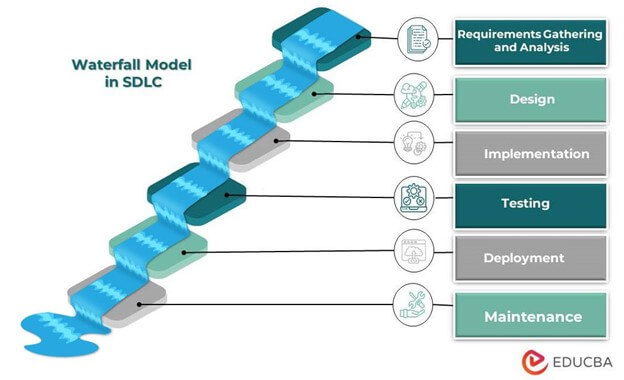Updated February 28, 2023
Waterfall Model in SDLC
The Waterfall model in SDLC (Software Development Life Cycle) is the first model introduced to represent the development of software in different phases.
In a paper written in 1970 about his experience writing software for satellites, Dr. Winston W. Royce of the Lockheed Software Technology Center introduced the idea. Royce spoke of the downstream value of documentation but avoided using the term waterfall.
Applications for industrial design continue to employ the waterfall approach. It is frequently mentioned as the initial software development methodology. The paradigm application is broader as a top-tier project management approach for challenging, diverse undertakings.
What is the Waterfall model?
The Waterfall model is a sequential software development model with several phases, each completed linearly. The model follows a series of steps: planning, design, implementation, testing, and maintenance. It is essential to complete each phase before starting the next one.
The Waterfall model is famous for software development projects with clear and well-defined requirements. A linear, sequential approach works best when the end goal is clearly defined, and there is a clear understanding of what the software must do.
Steps involved in the Waterfall model
Each step of the waterfall method relies on the results of the one before it. The development of these projects follows a linear pattern. These phases include
#1 Requirements Gathering and Analysis:- The first step in the Waterfall model is gathering and analyzing the project’s requirements. This includes understanding the project’s scope, identifying the stakeholders, and gathering information about the end users.
#2 Design:- Designing the software is the next step. This includes creating a software architecture, identifying the system components, and defining the interfaces between these components.
#3 Implementation:- The implementation phase begins once the design is complete. This involves writing the code for the software, integrating the components, and testing the software.
#4 Testing:- The following step is testing the software. This includes performing unit, integration, system, and acceptance tests.
#5 Deployment:- Once the testing is complete, the deployment of software happens in the production environment.
#6 Maintenance:- The final step is to maintain the software. This includes making changes to the software, fixing bugs, and providing technical support to the end users.
When to choose the Waterfall method?
#1 When There is a Well-Structured Plan For Execution
It is most effective when the teams or individuals working on the project fully comprehend the SDLC Waterfall Model. A model without challenging methods is simple to utilize. Even while it’s relatively easy to understand, implementation of the Waterfall model happens only when the answer to most of the questions that arise in the development is yes. Will the Waterfall model help the team to achieve the development efficiently? Will it expedite the procedure? And many more.
#2 When Less Risk Involved
The use of the SDLC Waterfall Model happens only when it imposes little risk. For instance, a team is confident enough to deliver the product without returning to the model’s earlier phases or if the project doesn’t require ongoing client interaction.
#3 When Requirements are Defined
Utilize the SDLC Waterfall Model to manage the various components of the project. There shouldn’t be any disagreements between the working team and the client.
Advantages and Disadvantages of the Waterfall Model
Some of the advantages and disadvantages of Waterfall Model are listed below:-
Advantages of the Waterfall Model
- The Waterfall model is easy to understand and use, which makes it a popular choice for software development projects.
- It provides a clear picture of the final product’s appearance and how it will function.
- The Waterfall model is a linear, sequential approach that makes it easier to estimate the time and resources required for each project phase.
- The Waterfall model is a reliable and predictable method for software development.
Disadvantages of the Waterfall Model
- The Waterfall model is unsuitable for projects with changing requirements, as it is a linear, sequential approach that does not allow to make changes once a phase is complete.
- The Waterfall model does not allow for feedback from the end-users
Final Thoughts
Using the waterfall model, guiding the team by monitoring the project’s moving parts is easy. It is a must when the team can finish tasks on schedule, allowing the developer to deliver the project to the clients when they anticipate it.
Recommended Articles
We hope that this EDUCBA information on “Advantages and Disadvantages of Waterfall Model” was beneficial to you. You can view EDUCBA’s recommended articles for more information,


